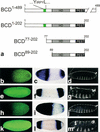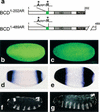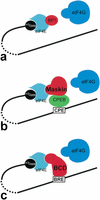Bicoid associates with the 5'-cap-bound complex of caudal mRNA and represses translation
- PMID: 12368268
- PMCID: PMC187448
- DOI: 10.1101/gad.240002
Bicoid associates with the 5'-cap-bound complex of caudal mRNA and represses translation
Abstract
Translational control plays a key role in many biological processes including pattern formation during early Drosophila embryogenesis. In this process, the anterior determinant Bicoid (BCD) acts not only as a transcriptional activator of segmentation genes but also causes specific translational repression of ubiquitously distributed caudal (cad) mRNA in the anterior region of the embryo. We show that translational repression of cad mRNA is dependent on a functional eIF4E-binding motif. The results suggest a novel mode of translational repression, which combines the strategy of target-specific binding to 3'-untranslated sequences and interference with 5'-cap-dependent translation initiation in one protein.
Figures




Similar articles
-
Sequence interval within the PEST motif of Bicoid is important for translational repression of caudal mRNA in the anterior region of the Drosophila embryo.EMBO J. 1999 Apr 1;18(7):1966-73. doi: 10.1093/emboj/18.7.1966. EMBO J. 1999. PMID: 10202159 Free PMC article.
-
A new paradigm for translational control: inhibition via 5'-3' mRNA tethering by Bicoid and the eIF4E cognate 4EHP.Cell. 2005 May 6;121(3):411-23. doi: 10.1016/j.cell.2005.02.024. Cell. 2005. PMID: 15882623
-
RNA recognition and translational regulation by a homeodomain protein.Nature. 1996 Feb 22;379(6567):694-9. doi: 10.1038/379694a0. Nature. 1996. PMID: 8602214
-
Drosophila development: homeodomains and translational control.Curr Biol. 1996 Jul 1;6(7):773-5. doi: 10.1016/s0960-9822(02)00591-2. Curr Biol. 1996. PMID: 8805294 Review.
-
Contrasting mechanisms of regulating translation of specific Drosophila germline mRNAs at the level of 5'-cap structure binding.Biochem Soc Trans. 2005 Dec;33(Pt 6):1544-6. doi: 10.1042/BST0331544. Biochem Soc Trans. 2005. PMID: 16246166 Review.
Cited by
-
The oncogene eIF4E: using biochemical insights to target cancer.J Interferon Cytokine Res. 2013 May;33(5):227-38. doi: 10.1089/jir.2012.0142. Epub 2013 Mar 8. J Interferon Cytokine Res. 2013. PMID: 23472659 Free PMC article. Review.
-
Control of messenger RNA fate by RNA-binding proteins: an emphasis on mammalian spermatogenesis.J Androl. 2012 May-Jun;33(3):309-37. doi: 10.2164/jandrol.111.014167. Epub 2011 Jul 14. J Androl. 2012. PMID: 21757510 Free PMC article. Review.
-
Shape and function of the Bicoid morphogen gradient in dipteran species with different sized embryos.Dev Biol. 2008 Apr 15;316(2):350-8. doi: 10.1016/j.ydbio.2008.01.039. Epub 2008 Feb 13. Dev Biol. 2008. PMID: 18328473 Free PMC article.
-
Crystal structure of a minimal eIF4E-Cup complex reveals a general mechanism of eIF4E regulation in translational repression.RNA. 2012 Sep;18(9):1624-34. doi: 10.1261/rna.033639.112. Epub 2012 Jul 25. RNA. 2012. PMID: 22832024 Free PMC article.
-
Optogenetic control of the Bicoid morphogen reveals fast and slow modes of gap gene regulation.Cell Rep. 2022 Mar 22;38(12):110543. doi: 10.1016/j.celrep.2022.110543. Cell Rep. 2022. PMID: 35320726 Free PMC article.
References
-
- Curtis D, Lehmann R, Zamore PD. Translational regulation in development. Cell. 1995;81:171–178. - PubMed
-
- Driever W. Maternal control of anterior development in the Drosophila embryo. In: Bate M, Martinez Arias A, editors. The development of Drosophila melanogaster. Cold Spring Harbor, NY: Cold Spring Harbor Laboratory Press; 1993. pp. 301–324.
-
- Driever W, Nüsslein-Volhard C. The Bicoid protein is a positive regulator of hunchback transcription in the early Drosophila embryo. Nature. 1989;337:138–143. - PubMed
-
- Driever W, Ma J, Nüsslein-Volhard C, Ptashne M. Rescue of bicoid mutant Drosophila embryos by bicoid fusion proteins containing heterologous activating sequences. Nature. 1989;342:149–154. - PubMed
Publication types
MeSH terms
Substances
LinkOut - more resources
Full Text Sources
Molecular Biology Databases
Miscellaneous
